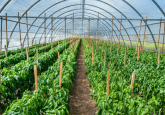Here today, gone tomato: researchers discover regulator of flowering time in tomatoes

Researchers have discovered a key protein that regulates tomato flowering time, which could enhance crop yield.
Controlling the timing of flowering in crops is essential for maximizing yields and adapting to changing climates; however, little is known about the mechanisms that regulate tomato flowering time. Now, a collaboration of researchers from Huazhong Agricultural University (Wuhan, China), Northwest A&F University (Xianyang, China), Zhumadian Academy of Agricultural Sciences (China) and the University of Idaho (ID, USA) has uncovered the molecular mechanism that helps control flowering time in tomatoes, which could help improve crop yield and resilience.
The flowering of crops helps transfer genetic material from parental plants to their offspring and is a prerequisite for producing fruits and seeds. The time a crop flowers affects seed and fruit production, making it a critical factor for crop yield and quality. While extensive research has been done on model plants such as Arabidopsis and rice, there is still limited knowledge about the mechanisms that control flowering time in tomatoes. With changing climates affecting the growing season, improving our understanding of these mechanisms is important to better manage crops in the face of climate change.
 Variety is the splice of life: how biodiversity is transforming biotech
Variety is the splice of life: how biodiversity is transforming biotech
In this interview, we talk to Phoebe Oldach – Head of the Global Research Team at Basecamp Research – about how her team is turning to nature to help build a more representative protein database that will not only help address the pollution problem, but other global challenges as well.
In a previous study, the researchers found that nuclear factors Y (NF-Ys), transcription factors that form complexes to regulate gene expression, play a crucial role in regulating flavonoid biosynthesis in tomato plants. The researchers therefore focused their efforts on determining whether NF-Ys also have a role in controlling flowering time in tomatoes.
They found that SlNF-YA3b, which encodes an NF-Y, was highly expressed in the floral primordia, implying a potential role in flowering control. Using CRISPR/Cas9 technology, the researchers created tomato plants with knocked-out SlNF-YA3b, which resulted in the plants flowering significantly earlier than the wild type. They also created plants with overexpressed SlNF-YA3b and observed delayed flowering.
The team then used a range of biochemical assays to understand how SlNF-YA3b controls flowering time. They found that SlNF-YA3b forms heterotrimeric protein complexes with multiple NF-YB/NF-YC heterodimers. They also found that SlNF-YA3b binds to the promoter of the SINGLE FLOWER TRUSS (SFT) gene, suppressing its expression. SFT is a homolog of the FLOWERING LOCUS T gene in Arabidopsis, which is widely believed to be the key component of the elusive flowering hormone florigen, which plays a pivotal role in flowering time control. This therefore suggests that SlNF-YA3b acts as a flowering time repressor in tomatoes.
The findings of this study open the door to manipulating SlNF-YA3b to control the flowering time of tomatoes, which could optimize fruit production and improve crop resilience to a changing climate.





